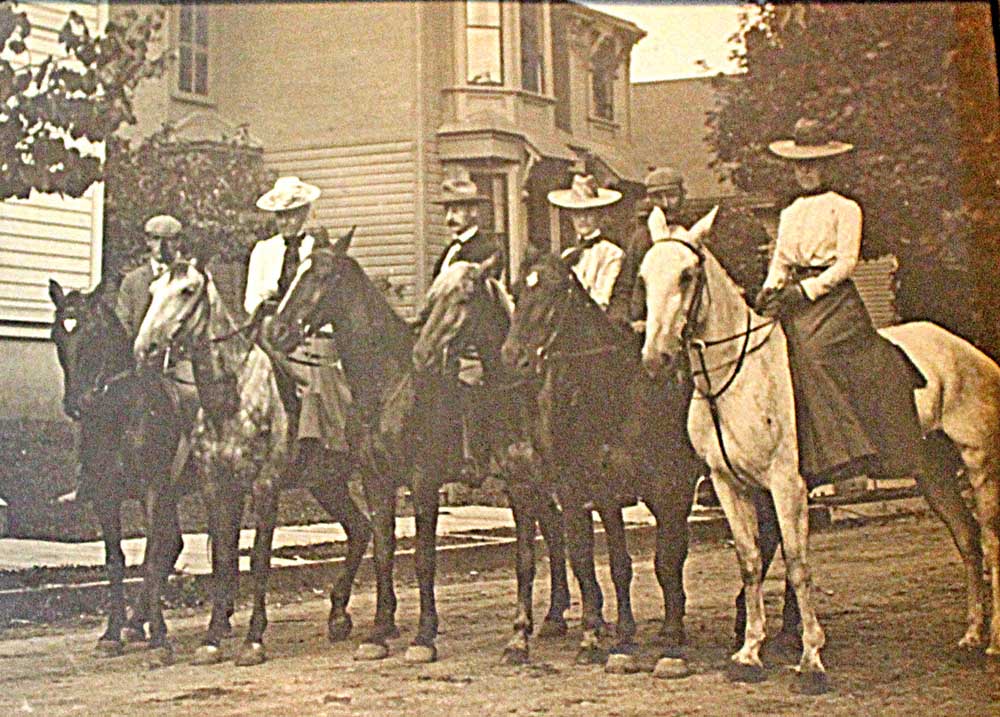Klipsan cabin recognized for historical value
Published 3:54 am Thursday, March 29, 2018

- Submitted photo The Shogren sisters, right and second left, with fellow riders at a social event in the early days of the 20th century.
KLIPSAN, Wash. — A beach house designed in 1908 for two prominent Northwest society dressmakers has been recognized for its historical value.
The Shogren House was named to the Washington Heritage Register and Washington state is asking that it be added to the National Register of Historic Places. It is likely to join the village of Oysterville, the Shelburne Hotel in Seaview, the Klipsan Beach Lifesaving Station and three private homes in Seaview and Ocean Park on the register.
The family members who own it are descendants of Anne and May Shogren, daughters of Swedish immigrants who designed and made one-of-a-kind formal dresses for Portland society women in the early years of the last century.
“I think I would die before I sold it; I couldn’t face that,” said Cosette Moore, whose great-grandmother, Lizzie, was sister and housekeeper to the Shogrens.
Moore’s daughter, Melissa Gardner, lives in Long Beach and works for the Salt Hotel. She has replaced damaged windows as part of her coursework in the historic preservation program at Clatsop Community College. The eight-bedroom beach cabin is packed with mementos from the Shogren sisters and their descendants, with each room laid out to celebrate its former occupant. Many furnishings, including antique dressers, are original to the cabin or came from the Shogren sisters’ grand home in the Mount Tabor Park district of Portland.
“It’s like living in a museum when you come here,” said the 37-year-old Gardner. “It’s so special — there’s so much family history. It’s amazing that there is this much that we still have.”
The Klipsan house was one of more than a dozen properties from around the state approved earlier this month for listing on the National Register, a federal program administered through the Washington State Advisory Council on Historic Preservation.
“Ours is the only one that is still in the original family,” Moore said.
Michael Houser, state architectural historian, visited the Klipsan building as part of the application process.
Listing on the register imposes no restrictions on the property owners. It allows federal tax credits for restoration in some cases and triggers a review if potential government actions would affect its value.
The cottage qualified because of its architecture; it was the work of Albert E. Doyle and his early partner, William B. Patterson. It cost about $3,500 and was completed in 1909. Doyle and Patterson’s other work set the tone for commercial buildings in Portland from the turn of the century to the early 1920s, especially in the use of glazed terracotta. Their cabins along the Washington state and Oregon coasts inspired a regional style widely emulated in the 1930s in places like Neahkahnie.
Doyle rose to prominence in Portland and Eugene, designing parts of Reed College, the Multnomah County Central Library, the Benson Hotel and the Meier & Frank Building.
The link to high-end fashion in the early days of the 20th century was also key.
“I think it’s a special place in terms of its architecture, its connection to the Shogren sisters and how the Long Beach Peninsula developed its tourist industry,” Houser said.
The peninsula flourished first as an oceanfront playground for the barons of commerce and Portland socialites who would escape the city by steamship and stagecoach. The Ilwaco Railroad and Steam Navigation Co. line later broadened its accessibility.
The Oregonian’s society page carried paragraphs listing their names and activities, which included enjoying the Canaris Bathhouse and the indoor seawater swimming pools at the Crystal Waters Natatorium. Visitors could rent skiffs on Willapa Bay, rent cars for $1 per hour, attend the movie theater, go clamming and fishing, or gather around beach bonfires.
Swedish immigrants Henry and Sophia Shogren settled in Portland in 1872 and had eight children. At 14, daughter May was apprenticed to Henry Litt’s tailoring shop then started her own dressmaking business in 1889. M&A Shogren Dressmakers developed when sister Anne joined her four years later, handling the administration while May created most designs.
American fashion was dictated by Paris so the Shogrens modified outfits they saw in fashion plates; they never used patterns, but would fit the fabrics directly to each customer. Later they traveled to New York and Paris for inspiration and to gather fabrics; creations were characterized by lace appliques and insertions, intricate layered bodices, extensive pleating and hand-beading.
At the height of their fame, the women employed 100 people during the first 10 years of the century. Their dresses sold internationally and some commanded a price equal to a Model T Ford. A 1915 ledger reveals their dresses started at about $100, with $250 being more typical, equivalent to $2,500 to $6,000 today. Customers included the wealthy and political elite.
In 1903, a fire severely damaged the Dekum Building, which housed the seventh-floor dress shop. It led to changes in city code that demanded enhanced fire escapes and greater water supplies in tall buildings.
The Oregonian lamented, “The destruction of the Shogren sisters’ dressmaking parlor means that many society ladies will have to appear at the next social function in dresses they have worn before … but the less fortunate ones have lost their fine robes, and will have to bear the pitying glances of lucky sisters at the next fashionable party.”
Although the Shogrens lost about $15,000, they soon rebuilt their business in the Madison Park Building. The height of their success was during Portland’s 1905 Lewis and Clark Exposition. Newspapers reported that Mary Bidwell Carey, the wife of Judge Charles H. Carey, wore a Shogren dress to the opening reception, and Emma Corbett, wife of Henry W. Corbett, wore one of deep purple silk velvet with ornate black and ivory lace, and a beaded bodice.
Coincidentally, Doyle, the architect, designed the Exposition’s Forestry Building, a rustic cabin dubbed the “Log Parthenon,” one of the few Exposition buildings intended to be permanent. It survived until 1964 before going up in a gigantic blaze.
The Shogren sisters were born in the 1860s; they never married or had children. They climbed Mount Hood in 1895 and were charter members of the Mazamas mountaineering club.
Anne Shogren was an accomplished equestrian, winning regional competitions. Photos on display at the Klipsan cottage show her and society ladies riding in elaborate hats. The sisters developed some of the earliest custom riding pants worn by American women, having their clients sit on a headless horse model in their fitting room.
They retired in 1920 as less elaborate, mass-produced clothing diminished demand for the custom-tailored dresses of the Victorian and Edwardian eras. The sisters died in 1928 and 1934. Some of their designs are preserved in the collections of the Oregon Historical Society and the Fashion Institute of Technology Museum in New York City.
The Shogrens’ summer cottage — sometimes referred to as the “Alder Sea” — was built on acreage purchased for $1,000 from L.A. Loomis of Long Beach. It is west of the highway and south of the Klipsan lifesaving station, which was established in 1891.
Completion of the North Jetty at the mouth of the Columbia River in 1916 caused sand to build up on the beaches, and the cottage now sits farther from the ocean than when it was built.
Moore’s grandmother, Elsie, and her husband, Aaron Gould, bought the house for $1,000 in 1940, although he died just a few years later. Elsie was familiar as the Sunday school teacher at Ocean Park United Methodist Church; she died in 1980. Moore’s aunt, Geraldine, lived in the house until 1995.
The Craftsman-style home has shingled siding and two porches, one with a swing built by the sisters’ father, Henry Shogren. It had its roof replaced in 2016 and four windows have been painstakingly repaired or replaced by Gardner retaining the same green trim.
The downstairs is finished in stained fir, with exposed walls and ceilings. It consists of a kitchen, pantry, two bedrooms and a living room with a large brick fireplace and space for a baby grand piano. Through double French doors is the dining room with a large antique original oak table that once seated as many as 22. U-shaped stairs take visitors up to six more bedrooms, one created from an attic. All are decorated with artifacts from the early and middle 20th Century.
For Cosette Moore, the 424-mile drive from Pomeroy is rewarded by relaxing at the cabin, surrounded by family history. She owns it jointly with a cousin in Eastern Oregon and five siblings in eastern Washington and Idaho. Daughter Melissa Gardner and her siblings, Ryan Gardner of Ilwaco and Jessica Gardner of Seaside, maintain it, cut the grass and clean the gutters.
Moore watches with pride as Melissa Gardner unrolls the crinkled 1909 blueprints and talks animatedly about the restoration work that will help earn her an associate degree in historical preservation this spring. “It’’s been really fun,” Gardner said. “Some sills had totally rotted away. They are kind of like new, but old — sort of.”
As the black-and-white images of her great aunts Anne and May in their ornate dresses stare down from photos on the wall, Moore strokes Sweetie, her 9-year-old black lab-collie mix, who guards the property attentively. When asked what the Shogren cottage means to her, the simplicity of her reply tells all.
“I love it.”





